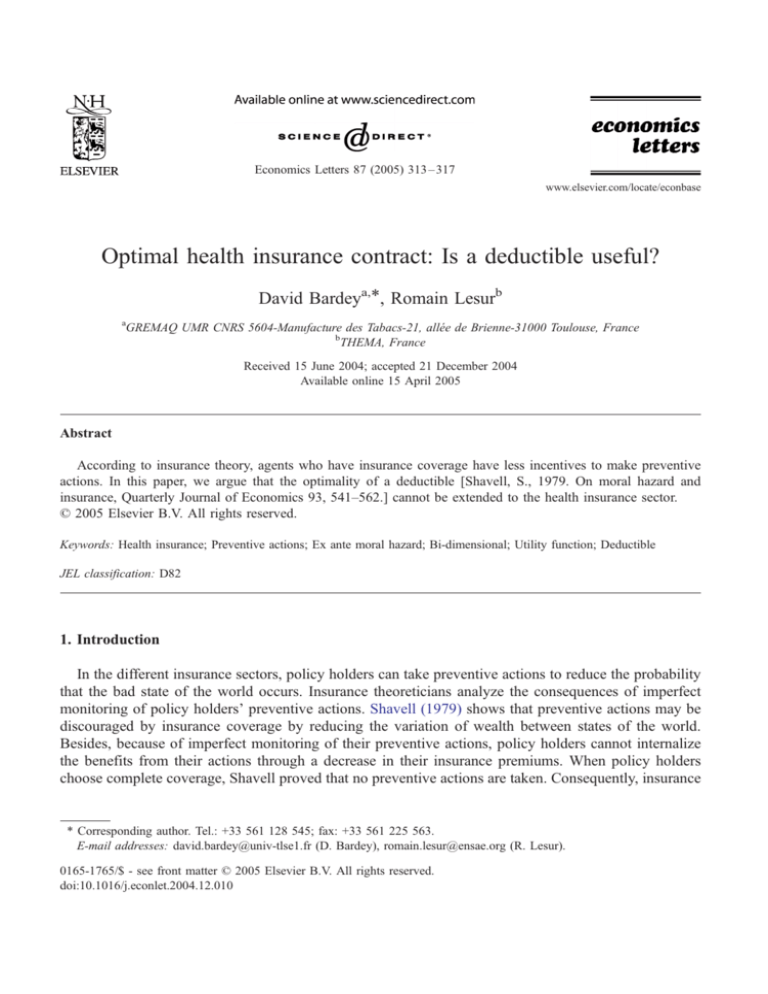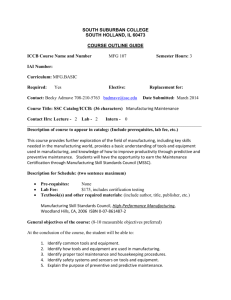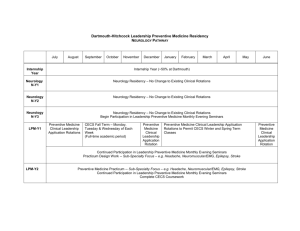
Economics Letters 87 (2005) 313 – 317
www.elsevier.com/locate/econbase
Optimal health insurance contract: Is a deductible useful?
David Bardeya,T, Romain Lesurb
a
GREMAQ UMR CNRS 5604-Manufacture des Tabacs-21, allée de Brienne-31000 Toulouse, France
b
THEMA, France
Received 15 June 2004; accepted 21 December 2004
Available online 15 April 2005
Abstract
According to insurance theory, agents who have insurance coverage have less incentives to make preventive
actions. In this paper, we argue that the optimality of a deductible [Shavell, S., 1979. On moral hazard and
insurance, Quarterly Journal of Economics 93, 541–562.] cannot be extended to the health insurance sector.
D 2005 Elsevier B.V. All rights reserved.
Keywords: Health insurance; Preventive actions; Ex ante moral hazard; Bi-dimensional; Utility function; Deductible
JEL classification: D82
1. Introduction
In the different insurance sectors, policy holders can take preventive actions to reduce the probability
that the bad state of the world occurs. Insurance theoreticians analyze the consequences of imperfect
monitoring of policy holders’ preventive actions. Shavell (1979) shows that preventive actions may be
discouraged by insurance coverage by reducing the variation of wealth between states of the world.
Besides, because of imperfect monitoring of their preventive actions, policy holders cannot internalize
the benefits from their actions through a decrease in their insurance premiums. When policy holders
choose complete coverage, Shavell proved that no preventive actions are taken. Consequently, insurance
T Corresponding author. Tel.: +33 561 128 545; fax: +33 561 225 563.
E-mail addresses: david.bardey@univ-tlse1.fr (D. Bardey)8 romain.lesur@ensae.org (R. Lesur).
0165-1765/$ - see front matter D 2005 Elsevier B.V. All rights reserved.
doi:10.1016/j.econlet.2004.12.010
314
D. Bardey, R. Lesur / Economics Letters 87 (2005) 313–317
contracts must contain a deductible in order to implement the optimal trade-off between risk
mutualization and incentives to reduce ex ante moral hazard inefficiencies.
This result is consistent with several insurance sectors where goods are replaceable.1 However, ex
ante moral hazard analysis in the field of health insurance has also to take account of health risk
specificities. Curative and preventive treatments are not always perfect substitutes as the efficiency of
curative treatments often depends on the preventive actions realized before. Health risk and health state
are more closed to the irreplaceable good problem described by Cook and Graham relative to the goods
covered in other insurance sectors.
Consequently, whatever the extent of coverage, preventive actions in this sector have repercussions on
the policy holders’ expected health state. Even if they are fully insured against medical expenses, they
have an incentive to spend to reduce the risk of being ill due to the fact that illness involves a utility loss.
In this paper, we suggest an ex ante moral hazard model where policy holders’ preferences are
represented by a bi-dimensional utility function, with the health state as the second dimension. Using this
sanitary dimension, we show that Shavell’s result is not always consistent: the optimal health insurance
contract may contain no deductible. The intuition is that a deductible lowers the policy holders’ wealths
in case of illness and then increases the marginal disutility of expenses in preventive actions because of
the decreasing marginal utility function (reflecting risk aversion in the expected utility framework). This
effect paradoxically tends to discourage preventive actions.
The first section describes the assumptions of the model, the second section derives the optimal health
insurance contract and the third section concludes.
2. Framework
We consider a representative consumer subject to the following assumptions:
! Two states of the world can occur, X = {B, G}. The state illness is noted B, and G is the state good
health. Each state of the world (B or G) is characterized by a pair (w B; h B) and (w G; h G) which define
the wealth w and the health state h of the representative consumer in the two states of the world. For
simplicity, we consider that health states h B and h G are constant, with h G N h B. We note
Dh = h G h B N 0 the health state loss caused by the disease.
! The probability of illness is denoted p. The consumer can decrease this probability taking preventive
actions e z 0. We assume p u p(e) with pV(e) V 0 and pW(e) z 0. We consider a health risk nondeterministic in the sense that: p(0) b 1 and limeYl pðeÞ ¼ pl N0.
These assumptions imply that pV converges to 0. This property implies that the marginal gain of the
preventive actions becomes negligible when these preventive actions are high enough.
The two states of the world belonging to the set X have two components: a financial risk and a risk of
deterioration of the health state. In order to capture this second risk, we use a bi-dimensional utility
function to represent the consumer’s preferences. The consumer chooses a preventive effort level not
only to reduce the financial risk but also to protect against the health state risk.
1
Replaceable in the sense of Cook and Graham (1977).
D. Bardey, R. Lesur / Economics Letters 87 (2005) 313–317
315
Preferences of the consumer are represented by the following utility function, v(w; h) that is assumed
to be additively separable:
vðw; hÞ ¼ uðwÞ þ h:
ð1Þ
This function is increasing and concave in wealth thus capturing risk aversion. The additive form of
the utility function allows the avoidance of wealth effects.2 Besides we assume no risk-aversion in the
health dimension in order to show that opposite results can be obtained even though we have a body of
assumptions very close to the Shavell’s one. This utility function can equally be interpreted as a statedependent utility function with an additive form (Karni, 1983). We assume too that this function verifies
Inada’s conditions: limwYl uVðwÞ ¼ l and limwYl uVðwÞ ¼ 0.
3. Ex ante moral hazard and optimal health insurance contract
Wealth levels in the two states of the world are:
wG uw̃
w G ðe; I; hÞ ¼ w0 e hI;
wB uw̃
w B ðe; I; hÞ ¼ w0 e þ ð1 hÞI L
¼ w̃
w S ðe; I; hÞ þ I L;
where I is the indemnity received by policy holders when they fall ill, L the health expenditure level in
case of illness and h is the premium by unit of coverage. In the case of full coverage (I = L):
w̃ G = w̃ B = w(e, I;h).
Since we are interested in the problem of ex ante moral hazard, the level of preventive actions is
determined by policy holders and is denoted by ẽ. The objective of policy holders is to maximize their
expected utility:
w B Þ þ hB þ ð1 pÞd ½uðw̃
w G Þ þ hG ẽe ð I; hÞ ¼ argmax pd½uðw̃
e
where ẽ is implicitly defined by the first-order condition of this program:
w B Þ þ DhÞ ¼ puVðw̃
w B Þ þ ð1 pÞuVðw̃
w G Þ:
pVd ðuðw̃
w G Þ uðw̃
ð2Þ
In the univaried Shavell’s framework (i.e. Dh = 0), the derivative of expected utility with respect to
effort level yields:
d
Ev ¼ pVd ðuðw̃
w G Þ uðw̃
w B ÞÞ pd uVðw̃
w B Þ ð1 pÞd uVðw̃
w G Þ:
de
Full coverage
of the financial risk (I = L) implies u(w B) = u(w G) and cancels the benefits of preventive
d
effort de Evb0 . With this bi-dimensional utility function, even though the health insurance premium is
2
This choice can be justified because the debate on the sign of U12 is still open (Rey, 2003).
316
D. Bardey, R. Lesur / Economics Letters 87 (2005) 313–317
not reduced because of the monitoring problem, the difference of the health in the two states of the world
implies that policy holders only partially internalize the benefit of their preventive actions.
It is interesting to write Shavell’s program to characterize the optimal health insurance contract in our
bivariate framework. Since interested in the optimum,3 we have h = p(e). This condition means that the
optimum analysis takes into account the impact of the effort on the premium, hence the effort level only
depends on the coverage I:
w B ðe; I; pðeÞÞÞ þ Dh ¼ pðeÞuVðw̃
w B ðe; I; pðeÞÞÞ
pVðeÞ½uðw̃
w G ðe; I; pðeÞÞÞ uðw̃
þð1 pðeÞÞuVðw̃
w G ðe; I; pðeÞÞÞ:
We denote ê u ê(I) the solution in e of the preceding equation. We also define the level of effort for
full coverage in the context of imperfect monitoring as e* = ê(L).
Expected utility is then computed using h = p(e) and the optimal effort done by policy holders ê. By
noting V(I), the expected utility with imperfect information is:
w G ðêe; I; pðêe ÞÞÞ þ hG :
V ð I Þ ¼ pðêe Þ½uðw̃
w B ðêe; I Þ; pðêe ÞÞ þ hB þ ð1 pðêe ÞÞ½uðw̃
The optimal coverage level is given by the maximization of V(I).
V Vð I Þu êeVpV½uðw̃
w G Þ uðw̃
w B Þ þ Dh êeV½ puVðw̃
w B Þ þ ð1 pÞuVðw̃
w G Þ êeVpVI½puVðw̃
wBÞ
w B Þ þ ð1 pÞuVðw̃
w G Þ þ puVðw̃
w B Þ:
þð1 pÞuVðw̃
w G Þ pd ½ puVðw̃
For full coverage, we obtain:
V Vð LÞ ¼ êeVð LÞpVðe4ÞLuVðwðe4; L; pðe4ÞÞÞ:
ð4Þ
The sign of VV(L) only depends on the sign of êV(L) and we have
êeVð LÞ ¼
pVðe4ÞuWðwðe4; L; pðe4ÞÞÞ pðe4ÞuWðwðe4; L; pðe4ÞÞÞ
pWðe4ÞDh uWðwðe4; L; pðe4ÞÞÞ
ðw0 e4pðe4ÞLÞ
pVðe4Þ
Proposition 1. If uW
uVðw0 e4pðe4ÞLÞ z pðe4Þ , in the neighborhood of full coverage, preventive efforts
are increasing with the indemnity level.
When the indemnity level varies, two effects are seen. The first is the traditional decrease in incentives
explained by Shavell: the increase of the indemnity level decreases the marginal benefit of preventive
actions. The second one was already present in the Shavell’s analysis but was eliminated in the situation
of full coverage. When the indemnity level increases, all other things equal, the policy holders become
richer when the bad state of the world occurs. This last effect comes from the decrease of the marginal
utility function that reduces the cost of preventive actions in the state B.4 The case êV(L) N 0 occurs when
3
No welfare loss is due to positive loading factor.
If preventive actions are not monetary, but rather inseparable from money utility terms, this effect and its consequences do not hold. In this
case, the optimal deductible is positive.
4
D. Bardey, R. Lesur / Economics Letters 87 (2005) 313–317
317
the health state variation between both states of the world induces a high effort (ê) to insure that pV(ê) is
low enough. Then, the incentives generated by a decrease in the indemnity level are too low and are
dominated by the wealth effect that implies an increase in the marginal cost of preventive actions.
Corollary 1. If the condition within Proposition 1 holds, full coverage is optimal.
4. Conclusion
The goal of this paper was to underline that it is sometimes ill advised to apply traditional insurance
models to the health insurance sector. We take into account of the health risk specificities via a bidimensional utility function that captures the risk of deterioration of health.
We showed that this second dimension can be a sufficient condition to make policy holders take
preventive actions. Our result implies that according to the health state variation intensity, it may be
suboptimal to introduce deductibles. We can interpret this result in the following sense: for small
diseases, a deductible may be optimal to introduce incentives when the bnatural incentivesQ are not
strong enough, however for strong disease, full coverage is optimal. In this last case, the introduction of
a deductible lowers the incentives by increasing the marginal cost of preventive actions. This result
implies that the presence of deductibles must be contingent at the severity of illness.
References
Cook, P., Graham, D., 1977. The demand for insurance and protection: the case of irreplaceable commodities. Quarterly Journal
of Economics 91, 143 – 156.
Karni, E., 1983. Risk aversion for state-dependent utility functions. International Economic Review 24, 637 – 647.
Rey, B., 2003. A note on optimal insurance in the presence of a nonpecuniary background risk. Theory and Decision 54,
173 – 183.
Shavell, S., 1979. On moral hazard and insurance. Quarterly Journal of Economics 93, 541 – 562.









